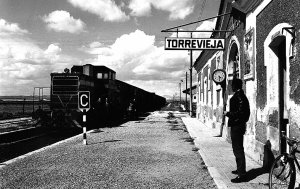
On 7 April 2016 the deadline for the feasibility study of the Torrevieja railway station was met. Since then, for over two years, the Ministry of Development has continued to maintain its silence on this important issue, even despite the constant demands of the City Council.
With over two years now having elapsed, without either solutions or answers from Madrid, Mayor José Manuel Dolón has now once again made contact with the Ministry, this time through an official document, requesting information on the current status of the project.
The Ministry originally proposed three options, but the City Council considered them all unworkable.
“It is unacceptable, there is a clear lack of will on the part of the Government, otherwise, we would have seen some progress, “Dolón told the media, “It is a small investment that would mean a lot to our municipality.”
Although the Ministry proposed the three options to bring trains back into Torrevieja, the City Council considered that they were unviable due to their high cost and environmental impact. One of them involved using the old line while the others required the construction of new lines along routes bordering the Natural Park of Las Lagunas and La Mata.
“The train has been justified for decades, but no government has been able to suggest a viable plan,” said Javier Manzanares, the Socialist councillor for transport.

The Torrevieja council has proposed an alternative option to those of central government which would see Torrevieja station taken away from the town centre. “The important thing is that we are connected to the national rail network, it is not so crucial that the station is six kilometres from the urban core. It will still be in our municipal district, and we will maintain it’s control,” said the councillor.
The idea is also to share the railway connection with the neighbouring municipalities, Rojales and Los Montesinos. “Our old station is now completely out of date, today it is only worthy of being a museum” says Manzanares.
The councillor also pointed out that by using this project it would hardly be necessary to expropriate land, and that the environment and the urban fabric would be much more respected.
There is almost complete accord among politicians, residents, traders, restaurateurs and businessmen in Torrevieja who all agree the need for the railway to finally connect one of the most popular tourist areas in Spain. However, some disagree on what kind of train the town deserves.
“I understand that everyone wants to have an AVE stop on their doorstep, but you have to be realistic. Today it could only be a pipedream to expect that we bring the high speed train to Torrevieja,” says Manzanares.
The Socialist councillor says that he is more in favour of approaching the matter step by step and start with a branch line. “But It would be a branch that linked us with the train line between Alicante and Murcia.”
Many residents also routinely demand a rail connection with Cartagena, especially since the AP-7 that connects with that city is a toll motorway.
In the meantime both the mayor and his government team assure the local public that they will continue badgering the Ministry until their demands are heard. In the last official response received by the City Council, it was noted that the Ministry of Development said “it is still analysing the socioeconomic impact of the project”.
Torrevieja had a railway line that was introduced to the city in 1884. It finally disappeared, along with its station, in the late 1970’s coinciding with the decline of the salt mining industry. The line came into the old train station which was built in the late 19th century, along the 7km track now occupied by the ‘Via Verde’ (the Green Road) that starts at the edge of Los Montesinos.
It has been felt for some time that as a result of the thousands of national and international tourists that come into the area every year, plus the high volume of foreign residents that are living in the city, that Torrevieja would benefit once more from being linked by rail to other destinations.
At present, the airport is over 50km distant, the bus system is limited and the railway system non-existent, so any improvement to the transport network would be seen as a major boost for both Torrevieja and also for the surrounding region.




